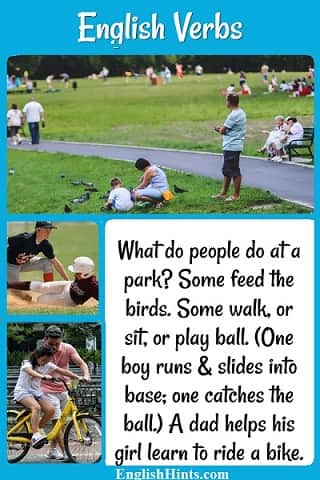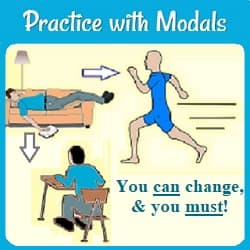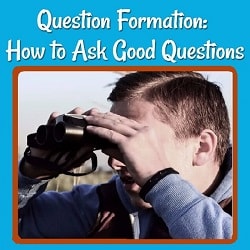English Verbs and How to Use Them
English verbs can express an action (run, bring, come, look, give, get, etc.) or a state of being (be, seem, appear, need.)
Verbs are simpler in English than in many languages.
Most have only two forms in the present tense and one form in other tenses.
In the present tense we use the base form for I, you, and all plurals.
For third person singular (he, she, it, Jack, Mrs. Smith, a tree, the city, etc.) we add an '-s' or sometimes '-es' to the end of the base form.
The verb 'to be' is an exception. It has three forms in the present and two in the past. It's so important that it is worth the extra study it takes.
Modal verbs are also exceptions, as they have only one form. For more on using modals and other helping verbs, see the Helping Verbs section below.
Types of Verbs: Transitive and Intransitive
Some verbs are transitive, which means they can take a direct object: (“She buys groceries.” I’m bringing a friend.” “Do you want an egg?” "Sue doesn't eat dessert.")
Others are intransitive and cannot take direct objects. (“Jeff is going to the store.”)
This matters because it will sound very strange to English speakers if you use an object with an intransitive verb. If you’re not sure, a dictionary will tell you if a verb is transitive or intransitive. (For more on direct objects and transitive and intransitive verbs see English Sentence Structure.)
Forms & Uses of English Verbs
Most English verbs (except ‘be’ and modals) have five forms plus the infinitive (‘to’ + base).
The forms are:
- the base (present tense, except for 3rd person singular),
- the 3rd person singular present tense form (almost always base +‘s’ or ‘es’),
- the present participle or gerund (base + ‘ing’),
- the simple past tense (if regular, base +‘d’ or ‘ed’-- but there are many irregulars),
- and the past participle.
These forms have several uses, as illustrated in the following table:
| Form | Uses | Examples |
|---|---|---|
| Infinitive | after many verbs* | I want to go. He needs to eat. |
| Infinitive | as a subject | “To err is human; to forgive, divine.” |
| Base form | present tense except 3rd p.s. | You go to bed early. We eat out a lot. |
| Base form | After modals & do | I can go. Does she eat out? |
| 3rd Person Sing. Pres. | present tense for one person or thing | Joe works Fridays but goes in late. His dog eats cat food. |
| Present Participle | after ‘be’ for continuous tenses | I’m going home. He’s eating cake. |
| Present Participle | to make nouns (or adjectives) | Skiing is fun. Bulimia is an eating disorder. |
| Present Participle | after some verbs* (instead of infinitive) | He enjoys going to school. Stop eating! |
| Present Participle | after prepositions (on, in, before, etc.) | Keep on going! They rest after eating. |
| Simple Past Form | to make the simple past tense | He went home early, but ate late. Ann lived at home & studied law. |
| Past Participle | after ‘have’ for perfect tenses. | They’ve gone home. Have you eaten? Dan had studied law too. |
| Past Participle | to make adjectives | It’s a required course. He’s bored. |
Verbs Followed by an Infinitive, a Gerund, or Either
* Use infinitives after: want, need, hope, plan, decide, learn, prepare, ask & many similar words.
*Use the present participle (-ing form, called a gerund in this case) after: enjoy, dislike, keep (on), give up, finish, stop, & a few others.
*Use either infinitives or gerunds with like, love, hate, begin. try, & a few others.
The grammar can be confusing. For most verb combinations, an infinitive is fine: "We want to go to the park." "He decided to learn English." "They asked to come in."
The biggest exception is probably 'enjoy.' We don't say "I enjoy to sing," but always "I enjoy singing." It's worth learning that one, since we use it so much.
If you would like to learn more about which verbs can be followed by infinitives, gerunds, or either form, or if you want to practice sentences using them, I have a free PDF worksheet on them here.
Helping Verbs
A few English verbs called modals cannot be used by themselves, but are helping verbs. Three other verbs (do, be, and have) can be used either as helping verbs or as the main verbs in a sentence.
Helping verbs come before and can change the meaning of the main verb. (The main verb is always in the base form after any helping verb except ‘be’ or ‘have.’)
English requires a helping verb before the main verb in questions and negatives. The helping verb alerts listeners to expect a negative or question. (The verb ‘be’ is an exception. Even when it is not a helping verb, it can be used alone in questions and negatives.)
Modal Verbs are special helping verbs like can, could, will, would, might, or should. They do not change form according to person.We say: I can, he can, they can, or you would, he would. (They do not take an ‘s’ for 3rd person singular.) See Modal Verbs for more information.
There are three non-modal helping verbs which can also serve as main verbs:
- do
- have
- be
As helping verbs, these also come before a main verb and change its meaning or tense. Unlike modals, ‘do’, ’have’, and ‘be’ are conjugated: they change their forms depending on person and tense.
We use the base form of the main verb after ‘do.’ After ‘have’ we use the past participle of the main verb (ending in -ed except for irregulars-- see Irregular Verbs as well as the Simple Past Tense). After ‘be’ we use the present participle (-ing form) of the main verb.
Some Examples Using Do, Have, and Be As Helping Verbs:
- “Do you go to the store every week?”
“(Yes,) I do.”
- “Does Jerry go fishing every summer?”
“No, he doesn’t.”
- “ Did they eat cake last night?”
“ No, they didn’t.”
- “Have you studied for the test yet?”
“ I’ve been studying since last week. I had learned this all a year ago, but I haven’t reviewed it, so I forgot a lot.”
- “Are you going to Sally’s party?”
“No. I’m going to study instead.”
“That’s too bad. Sally is planning a special meal!”
“I know. I was hoping I could go.”
For more examples using the helping verbs do, have, be, and modals, see:
How to make negative sentences in English: a guide to helping verbs, negative words, and traps to avoid, with examples of each.
Practice using modals by studying the examples, then choosing the correct verb forms to fill in the blanks in several conversations.
How to form questions in English: a simple explanation with lots of examples using question words and helping verbs.
Don’t be scared by English verbs-- and don’t worry if you sometimes make mistakes using them. That's O. K. Just keep listening and keep practicing.
It won’t be long until they’ll seem easy!
Home> English Grammar Lessons> English Verbs.
Didn't find what you
needed? Explain what you want in the search box below.
(For example, cognates, past tense practice, or 'get along with.') Click to see the related pages on EnglishHints.
| site search by freefind | advanced |









